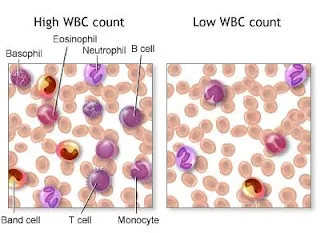Definition
The WBC number is a blood test to measure the number of white blood cells (WBCs) in the blood.
WBCs are also called leukocytes. They help fight disease. There are five major types of white blood cells:
- Basophils
- Eosinophils
- Lymphocytes (T cells, B cells, and Natural Killer cells)
- Monocytes
- Neutrophils
Alternative Names
Leukocyte counts; Calculation of white blood cells; Differences in white blood cells; WBC differences; Infection - WBC count; Cancer - WBC count
How the Test is Performed
A blood sample is needed.
How to Prepare for the Test
Most of the time, you do not need to take special steps before this test. Tell your healthcare provider about the medications you are taking, including those that do not have a prescription. Some medications can change test results.
How the Test will Feel
When a needle is inserted to draw blood, some people experience moderate pain. Some feel only beaten or stung. After that, there may be some bruises or minor injuries. This will soon end.
Why the Test is Performed
You will have this test to find out how many WBCs you have. Your provider may order this test to help diagnose conditions such as:
- An infection
- Allergic reaction
- Inflammation
- Blood cancer such as leukemia or lymphoma
Normal Results
The average number of WBCs in the blood is 4 500 to 11,000 WBCs per microliter (4.5 to 11.0 × 109/L).
The standard price range may vary slightly between different labs. Some labs use different scales or can test different types. Talk to your provider about your test results.
What Abnormal Results Mean
SMALL WBC COUNT
The low number of WBCs is called leukopenia. Less than 4,500 cells per microlita (4.5 × 109 / L) is less than normal.
Neutrophils are one type of WBC. They are essential in the fight against disease.
A lower WBC score may be due to:
- Bone marrow failure or failure (for example, due to infection, tumor or abnormal scar)
- Cancer treatment, or other medications (see list below)
- Some autoimmune problems such as lupus (SLE)
- Liver disease or spleen
- Radiation therapy for cancer
- Certain viral infections, such as mononucleosis (mono)
- Cancer that damages the bone marrow
- The most severe bacterial infection
- Severe emotional or physical stress (such as injury or surgery)
HIGH WBC COUNT
The highest number of WBCs is called leukocytosis. It could be due to:
- Certain drugs or medications (see list below)
- Smoking cigarettes
- After surgery to remove the spleen
- Infections are usually caused by germs
- Inflammatory diseases (such as rheumatoid arthritis or allergies)
- Leukemia or Hodgkin's disease
- Tissue damage (e.g., burns)
There may be very unusual reasons for the unusual WBC count.
Decrease WBC count Drug
Drugs that can reduce your WBC count include:
- Antibiotics
- Anticonvulsants
- Antithyroid drugs
- Arsenicals
- Captopril
- Chemotherapy drugs
- Chlorpromazine
- Clozapine
- Diuretics (water pills)
- Histamine-2 blockers
- Sulfonamides
- Quinidine
- Terbinafine
- Ticlopidine
WBC count Increase Drugs
Drugs that may increase WBC counts include:
- Beta adrenergic agonists (for example, albuterol)
- Corticosteroids
- Epinephrine
- Granulocyte colony stimulating factor
- Heparin
- Lithium
Risks
There is a small risk involved in taking your blood. Arteries and veins vary in size from one person to another, and from one side of the body to the other. Getting a blood sample from some people may be more difficult than for others.
Other risks associated with blood transfusions are minor, but may include:
- Excessive bleeding
- Fainting or feeling lightheaded
- Multiple punctures to locate veins
- Hematoma (blood accumulating under the skin)
- Infection (a slight risk any time the skin is broken)

Comments
Post a Comment
Thanks to Come on Comment section